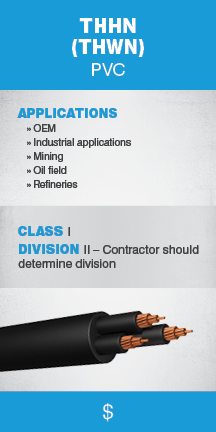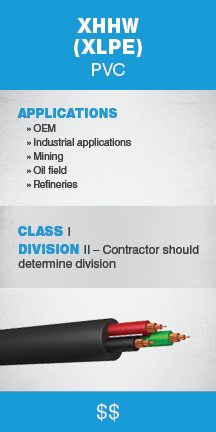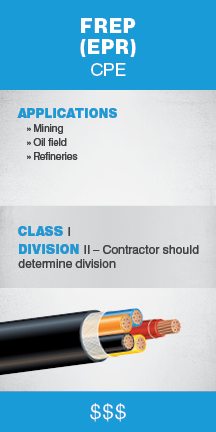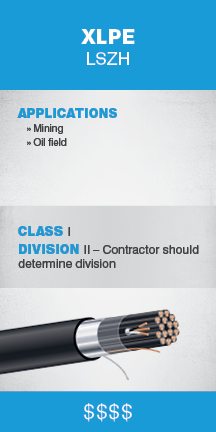[vc_row][vc_column][vc_column_text]It is important to understand the basic aspects of a cable’s construction and performance. Knowing the fundamental characteristics of tray cable will help you understand your product options, and allow you to make better wire and cable choices.
The National Electric Code (NEC) defines tray cable as:
“a factory assembly of two or more insulated conductors, with or without associated bare or covered grounding conductors under a nonmetallic sheath, for installation in cable trays, in raceways, or where supported by a messenger wire.”
Simply put, tray cable is a versatile cable approved for installation in cable trays or raceways. Tray cable comes in multiconductor and multipair styles that can be used for control, instrumentation/signal, power and lighting.
Tray cable is the all-around cable. It can be used in wet or dry locations, indoors or outside, and shielded or left out in the open. The power it provides can support structures of any size. Because of this versatility, tray cable is necessary to a wide range of industries from light industrial applications to the heaviest projects on the market. Tray cables can also be a great asset to a variety of utility and construction companies.
General Features and Needs of Tray Cable:
- Effective in direct sunlight or buried underground (as long as approved for those uses)
- Can be used indoors to power parts of a home, office building or other structures
- Other installations approved for building wire
- Can be used outdoors
- Sunlight-resistant
- Will work even if exposed from conduit to equipment
- Must be supported every six feet
- Must meet exposed run requirement of the property it is on
Insulation
- Typical materials used for insulation:
- Thermoplastic high heat-resistant nylon (THHN)
- Thermoplastic high heat-resistant nylon water-resistant (THWN)
- Cross-linked polyolefin (XLPO)
- Ethylene propylene rubber (EPR)
- Flame retardant ethylene propylene (rubber) (FREP/FR-EPR)
- Cross-linked polyethylene (XLPE/XHHW)
Jacket
- Typical jacket materials:
- Polyvinyl chloride (PVC)
- Chlorinated polyethylene (CPE)
- Low smoke zero halogen (LSZH)
Voltages
- Instrumentation cable 600 V or 300 V
- Instrumentation 600 V
- Power limited tray cable (PLTC) 300 V
- Exposed run (TC-ER) 600 V
- Control cable 600 V
- Power cable 600 V




XHHW vs. THHN Tray Cable
Cross-linked polyethylene high heat-resistant water-resistant (XHHW) tray cables are constructed meeting the UL 1277 Tray Cable requirements for 600 V tray cable installations. The IEEE 1202 FT 4 Riser flame test requirements are also included. These constructions are 90º C products that in most cases are direct bury, sunlight-resistant and may or may not be rated as exposed run.
XHHW tray cables are more robust than their THHN counterpart given that they are made with a thermoset insulation. XLPE hardens under increased temperature. XHHW insulations lend themselves to less deformation in high heat and overcurrent situations giving the installation a higher level of protection against short circuits and fires.
THHN is traditional tray cable not nearly as robust as an XHHW. Insulation jackets are made with thermoplastic materials that are subject to damage in high-heat conditions. The product is low cost but exhibits reduced resistance to heat, moisture and pest attack. THHN is prone to attack by rodents and ants.
Difference Between Class I Division I and Class I Division II Cable
Class 1 Division 1 (2104 NEC 500.5)
This cable is designed for areas where there is or may be an explosive atmosphere of gases or vapors mixed with air present during normal operation, for any reason.
Class 1 Division 2 (2014 NEC 500.5)
This cable is designed for areas where there is an explosive atmosphere of gases or vapors mixed with air when an abnormal condition exists, such as failure of a containment wall or ventilation system.
The site designer and local inspectors determine which class should be used, and the contractor should determine the division. Your distributor does not determine which class and division of products to use.
Standards and Guidelines
UL Requirements
UL 83 – Thermoplastic Wire and Cable
UL 44 – Thermoset Insulated Wire and Cable
UL 1277 – Electrical Power and Control Tray Cable
UL Requirements for Sunlight Resistance and Direct Bury
IEEE 1202 (70K BTU/Hr) Vertical Tray Flame Test – FT4 Canadian Equivalent
CSA 22.3 for -40 Cold Bend – 35 Cold Impact Requirements
Industrial and Utility Standards
NFPA 70 – NEC 336
NEMA WC57/ICEA S-73-532
ICEA T-29-520 210,000 BTU/Hr Flame Test
Border States Stocks and Cuts Tray Cable
Border States is authorized to stock these cables in all locations. We also offer a suite of services and solutions, including but not limited to: wire and cable cut-to-length and paralleling, specialized wire and cable reels, wire and cable scrap services, wire and cable pulling heads, and cable management programs.
Learn more about our wire and cable management services.
[/vc_column_text][/vc_column][/vc_row]